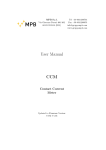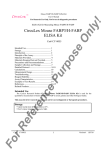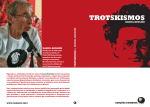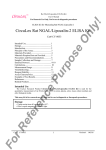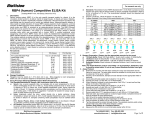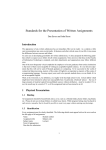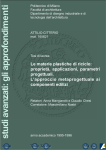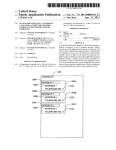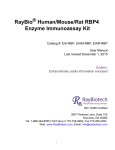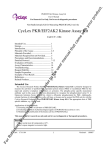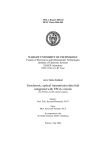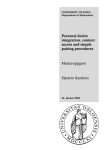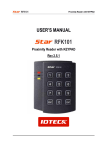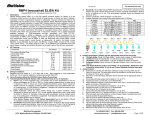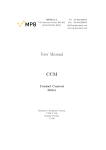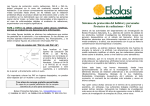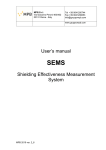Download Data Sheet
Transcript
CircuLex Human RBP4 ELISA Kit User’s Manual For Research Use Only, Not for use in diagnostic procedures ELISA Kit for Measuring Human RBP4 On ly! TM CircuLex Human RBP4 ELISA Kit Pu Intended Use................................................ 1 Storage......................................................... 1 Introduction.................................................. 2 Principle of the Assay.................................. 2-3 Materials Provided....................................... 3 Materials Required but not Provided........... 4 Precautions and Recommendations............. 5 Sample Collection and Storage.....................6 Detailed Protocol......................................... 7-8 Calculations..................................…............ 9 Measurement Range..................................... 9 Troubleshooting........................................... 9 Reagent Stability.......................................... 10 Assay Characteristics................................... 10-12 Example of Test Results................................13-14 References..................................................... 15 Related Products........................................... 16 rp os e Cat# CY-8072 ce Intended Use The CycLex Research Product CircuLex Human RBP4 ELISA Kit is used for the quantitative measurement of Human Retinol Binding Protein 4 (RBP4) in serum, plasma and other biological media. en This assay kit is for research use only and not for use in diagnostic or therapeutic procedures. Storage rR ef er • Upon receipt store all components at 4°C. • Don’t expose reagents to excessive light. Fo Cat#: CY-8072 1 Version#: 120710 CircuLex Human RBP4 ELISA Kit User’s Manual For Research Use Only, Not for use in diagnostic procedures On ly! TM Introduction rp os e Members of the lipocalin family, RBP4, FABP4 and NGAL (Lipocalin 2), which are produced from adipocytes, have recently been reported to play important roles in regulating systemic energy homeostasis, insulin sensitivity, and inflammation in animal models (1-5). Transgenic overexpression of RBP4 or injection of recombinant RBP4 in normal mice causes insulin resistance (1). Conversely, genetic deletion of RBP4 enhances insulin sensitivity. Graham et al. (2006) found that serum RBP4 levels correlated with the magnitude of insulin resistance in human subjects with obesity, impaired glucose tolerance, or type 2 diabetes and in non-obese, non-diabetic subjects with a strong family history of type 2 diabetes (6). Elevated serum RBP4 was associated with components of the metabolic syndrome, including increased body mass index (BMI), waist-to-hip ratio, serum triglyceride levels, and systolic blood pressure and decreased high-density lipoprotein cholesterol levels (6-8). Adipocyte GLUT4 protein and serum RBP4 levels were inversely correlated. Graham et al. concluded that RBP4 is elevated in serum before the development of frank diabetes and appears to identify insulin resistance and associated cardiovascular risk factors in subjects with varied clinical presentations. Principle of the Assay rR ef er en ce Pu The CircuLex Human RBP4 ELISA Kit employs the quantitative sandwich enzyme immunoassay technique. An antibody specific for Human RBP4 has been pre-coated onto a microplate. Standards and samples are pipetted into the wells and the immobilized antibody binds any Human RBP4 present. After washing away any unbound substances, an HRP conjugated monoclonal antibody specific for Human RBP4 is added to the wells. Following a wash to remove any unbound antibody HRP conjugate, the remaining conjugate is allowed to react with the substrate H2O2-tetramethylbenzidine. The reaction is stopped by addition of acidic solution and absorbance of the resulting yellow product is measured at 450 nm. The absorbance is proportional to the concentration of Human RBP4. A standard curve is constructed by plotting absorbance values versus Human RBP4 concentrations of calibrators, and concentrations of unknown samples are determined using this standard curve. The CircuLex Human RBP4 ELISA Kit is designed to measure the concentration of Human RBP4 from human serum/plasma, cell lysate of cultured human cell lines and cell culture conditioned medium. Fo Cat#: CY-8072 2 Version#: 120710 CircuLex Human RBP4 ELISA Kit User’s Manual For Research Use Only, Not for use in diagnostic procedures Summary of Procedure Add 100 µL of diluted sample to the wells Incubate for 1 hour at room temp. Wash the wells On ly! TM Add 100 µL of HRP conjugated anti-Human RBP4 monoclonal antibody Wash the wells rp os e Incubate for 1 hour at room temp. Add 100 µL of Substrate Reagent Add 100 µL of Stop Solution Pu Measure absorbance at 450 nm Materials Provided ce All samples and standards should be assayed in duplicate. The following components are supplied and are sufficient for the one 96-well microplate kit. Microplate: One microplate supplied ready to use, with 96 wells (12 strips of 8-wells) in a foil, zip-lock bag with a desiccant pack. Wells are coated with anti-Human RBP4 antibody as a capture antibody. en 10X Wash Buffer: One 100 mL bottle of 10X buffer containing 2%Tween®-20 Dilution Buffer: One bottle containing 50 mL of 1X buffer; use for sample dilution. Ready to use. Human RBP4 Standard: Two vials containing each 200 ng of lyophilized Human RBP4. er HRP conjugated Detection Antibody: One vial containing 12 mL of HRP (horseradish peroxidase) conjugated anti-Human RBP4 monoclonal antibody. Ready to use. ef Substrate Reagent: One bottle containing 20 mL of the chromogenic substrate, tetra-methylbenzidine (TMB). Ready to use. rR Stop Solution: One bottle containing 20 mL of 1 N H2SO4. Ready to use. Fo Cat#: CY-8072 3 Version#: 120710 CircuLex Human RBP4 ELISA Kit User’s Manual For Research Use Only, Not for use in diagnostic procedures On ly! TM Materials Required but not Provided • Pipettors: 2-20 µL, 20-200 µL and 200-1000 µL precision pipettors with disposable tips. • Precision repeating pipettor • Orbital microplate shaker • Microcentrifuge and tubes for sample preparation. rp os e • Vortex mixer • Microplate washer: optional (Manual washing is possible but not preferable) • Plate reader capable of measuring absorbance in 96-well plates at dual wavelengths of 450 nm/540 nm. Dual wavelengths of 450/550 or 450/595 nm can also be used. The plate can also be read at a single wavelength of 450 nm, which will give a somewhat higher reading. • Software package facilitating data generation and analysis :optional • Reagent reservoirs • Deionized water of the highest quality rR ef er en ce • Disposable paper towels Pu • 500 or 1000 mL graduated cylinder Fo Cat#: CY-8072 4 Version#: 120710 CircuLex Human RBP4 ELISA Kit User’s Manual For Research Use Only, Not for use in diagnostic procedures Precautions and Recommendations • Allow all the components to come to room temperature before use. On ly! TM • All microplate strips that are not immediately required should be returned to the zip-lock pouch, which must be carefully resealed to avoid moisture absorption. • Do not use kit components beyond the indicated kit expiration date. rp os e • Use only the microtiter wells provided with the kit. • Rinse all detergent residue from glassware. • Use deionized water of the highest quality. • Do not mix reagents from different kits. • The buffers and reagents used in this kit contain NaN3 as preservatives. Care should be taken to avoid direct contact with these reagents. • Do not mouth pipette or ingest any of the reagents. Pu • Do not smoke, eat, or drink when performing the assay or in areas where samples or reagents are handled. • Dispose of tetra-methylbenzidine (TMB) containing solutions in compliance with local regulations. • Avoid contact with the acidic Stop Solution and Substrate Solution, which contains hydrogen peroxide. ce • Wear gloves and eye protection when handling immunodiagnostic materials and samples of human origin, and these reagents. In case of contact with the Stop Solution and the Substrate Solution, wash skin thoroughly with water and seek medical attention, when necessary. en • Biological samples may be contaminated with infectious agents. Do not ingest, expose to open wounds or breathe aerosols. Wear protective gloves and dispose of biological samples properly. rR ef er • CAUTION: Sulfuric Acid is a strong acid. Wear disposable gloves and eye protection when handling Stop Solution. Fo Cat#: CY-8072 5 Version#: 120710 CircuLex Human RBP4 ELISA Kit User’s Manual For Research Use Only, Not for use in diagnostic procedures On ly! TM Sample Collection and Storage Serum: Use a serum separator tube and allow samples to clot for 60 ± 30 minutes. Centrifuge the samples at 4°C for 10 minutes at 1,000 x g. Remove serum and assay immediately or store samples on ice for up to 6 hours before assaying. Aliquots of serum may also be stored at below -70°C for extended periods of time. Avoid repeated freeze-thaw cycles. rp os e Plasma: Collect plasma using EDTA-Na2 as the anticoagulant. If possible, collect the plasma into a mixture of EDTA-Na2 and Futhan5 to stabilize the sample against spontaneous in vitro complement activation. Immediately centrifuge samples at 4°C for 15 minutes at 1,000 x g. Assay immediately or store samples on ice for up to 6 hours before assaying. Aliquots of plasma may also be stored at below -70°C for extended periods of time. Avoid repeated freeze-thaw cycles. Note: Citrate plasma has not been validated for use in this assay. rR ef er en ce Pu Other biological samples: Remove any particulates by centrifugation and assay immediately or aliquot and store samples at below -70°C. Avoid repeated freeze-thaw cycles. Fo Cat#: CY-8072 6 Version#: 120710 CircuLex Human RBP4 ELISA Kit User’s Manual For Research Use Only, Not for use in diagnostic procedures On ly! TM Detailed Protocol The CycLex Research Product CircuLex Human RBP4 ELISA Kit is provided with removable strips of wells so the assay can be carried out on separate occasions using only the number of strips required for the particular determination. Since experimental conditions may vary, an aliquot of the Human RBP4 Standard within the kit, should be included in each assay as a calibrator. Disposable pipette tips and reagent troughs should be used for all liquid transfers to avoid cross-contamination of reagents or samples. Preparation of Working Solutions rp os e All reagents need to be brought to room temperature prior to the assay. Assay reagents are supplied ready-to-use, with the exception of 10X Wash Buffer and Human RBP4 Standard. 1. Prepare a working solution of Wash Buffer by adding 100 mL of the 10X Wash Buffer to 900 mL of deionized (distilled) water (ddH2O). Mix well. Store at 4°C for two weeks or -20°C for long-term storage. 2. Reconstitute Human RBP4 Standard with 1.0 mL of ddH2O. The concentration of the human RBP4 in vial should be 200 ng/mL, which is referred as a Master Standard of human RBP4. Pu Prepare Standard Solutions as follows: Use the Master Standard to produce a dilution series (below). Mix each tube thoroughly before the next transfer. The 100 ng/mL standard (Std.1) serves as the highest standard. The Dilution Buffer serves as the zero standard (Blank). Volume of Standard 300 µL of Master Standard 300 µL of Std. 1 (100 ng/mL) 300 µL of Std. 2 (50 ng/mL) 300 µL of Std. 3 (25 ng/mL) 300 µL of Std. 4 (12.5 ng/mL) 300 µL of Std. 5 (6.25 ng/mL) 300 µL of Std. 6 (3.13 ng/mL) en ce Std.1 Std.2 Std.3 Std.4 Std.5 Std.6 Std.7 Blank - Dilution Buffer 300 µL 300 µL 300 µL 300 µL 300 µL 300 µL 300 µL 300 µL Concentration 100 ng/mL 50 ng/mL 25 ng/mL 12.5 ng/mL 6.25 ng/mL 3.13 ng/mL 1.56 ng/mL 0 ng/mL er Note: Do not use a Repeating pipette. Change tips for every dilution. Wet tip with Dilution Buffer before dispensing. Unused portions of Standards should be aliquoted and stored at below -70°C immediately. Avoid multiple freeze and thaw cycles. Sample Preparation rR ef • Serum and plasma samples require a 2,500-fold dilution. e.g. First: Make 50-fold dilution (2 µL of sample + 98 µL of Dilution Buffer) Second: Make 2,500-fold dilution (6 µL of 50-fold diluted sample + 294 µL Dilution Buffer) Don’t store diluted samples. • Other biological samples require neat, 10- and 100-fold dilution. Fo Cat#: CY-8072 7 Version#: 120710 CircuLex Human RBP4 ELISA Kit User’s Manual For Research Use Only, Not for use in diagnostic procedures Assay Procedure On ly! TM 1. Remove the appropriate number of microtiter wells from the foil pouch and place them into the well holder. Return any unused wells to the foil pouch, refold, seal with tape and store at 4°C. 2. Dilute samples with Dilution Buffer. (See “Sample Preparation” above.) 3. Pipette 100 µL of Standard Solutions (Std1-Std7, Blank) and diluted samples in duplicates, into the appropriate wells. rp os e 4. Incubate the plate at room temperature (ca.25°C) for 1 hour, shaking at ca. 300 rpm on an orbital microplate shaker. 5. Wash 4-times by filling each well with Wash Buffer (350 µL) using a squirt bottle, multi-channel pipette, manifold dispenser or microplate washer. 6. Add 100 µL of HRP conjugated Detection Antibody into each well. 7. Incubate the plate at room temperature (ca.25°C) for 1 hour, shaking at ca. 300 rpm on an orbital microplate shaker. Pu 8. Wash 4-times by filling each well with Wash Buffer (350 µL) using a squirt bottle, multi-channel pipette, manifold dispenser or microplate washer. 9. Add 100 µL of Substrate Reagent. Avoid exposing the microtiter plate to direct sunlight. Covering the plate with e.g. aluminum foil is recommended. Return Substrate Reagent to 4°C immediately after the necessary volume is removed ce 10. Incubate the plate at room temperature (ca. 25°C) for 10-20 minutes, shaking at ca. 300 rpm on an orbital microplate shaker. The incubation time may be extended up to 30 minutes if the reaction temperature is below than 20°C. en 11. Add 100 µL of Stop Solution to each well in the same order as the previously added Substrate Reagent. er 12. Measure absorbance in each well using a spectrophotometric microplate reader at dual wavelengths of 450/540 nm. Dual wavelengths of 450/550 or 450/595 nm can also be used. Read the microplate at 450 nm if only a single wavelength can be used. Wells must be read within 30 minutes of adding the Stop Solution. rR ef Note-1: Complete removal of liquid at each step is essential to good performance. After the last wash, remove any remaining Wash Buffer by aspirating or decanting. Invert the plate and blot it against clean paper towels. Note-2: Reliable standard curves are obtained when either O.D. values do not exceed 0.2 units for the blank (zero concentration), or 2.5 units for the highest standard concentration. The plate should be monitored at 5-minute intervals for approximately 30 minutes. Note-3: If the microplate reader is not capable of reading absorbance greater than the absorbance of the highest standard, perform a second reading at 405 nm. A new standard curve, constructed using the values measured at 405 nm, is used to determine Human RBP4 concentration of off-scale samples. The readings at 405 nm should not replace the on-scale readings at 450 nm. Fo Cat#: CY-8072 8 Version#: 120710 CircuLex Human RBP4 ELISA Kit User’s Manual For Research Use Only, Not for use in diagnostic procedures On ly! TM Calculations rp os e Average the duplicate readings for each standard, control, and sample and subtract the average zero standard optical density. Plot the optical density for the standards versus the concentration of the standards and draw the best curve. The data can be linearized by using log/log paper and regression analysis may be applied to the log transformation. To determine the Human RBP4 concentration of each sample, first find the absorbance value on the y-axis and extend a horizontal line to the standard curve. At the point of intersection, extend a vertical line to the x-axis and read the corresponding Human RBP4 concentration. If the samples have been diluted, the concentration read from the standard curve must be multiplied by the dilution factor. 1. The dose-response curve of this assay fits best to a sigmoidal 5-parameter logistic equation. The results of unknown samples can be calculated with any computer program having a 5-parameter logistic function. It is important to make an appropriate mathematical adjustment to accommodate for the dilution factor. 2. Most microtiter plate readers perform automatic calculations of analyte concentration. The calibration curve is constructed by plotting the absorbance (Y) of calibrators versus log of the known concentration (X) of calibrators, using the four-parameter function. Alternatively, the logit log function can be used to linearize the calibration curve (i.e. logit of absorbance (Y) is plotted versus log of the known concentration (X) of calibrators). Pu Measurement Range The measurement range is 1.56 ng/mL to 100 ng/mL. Any sample reading higher than the highest standard should be diluted with Dilution Buffer in higher dilution and re-assayed. Dilution factors need to be taken into consideration in calculating the human RBP4 concentration. ce Troubleshooting en 1. The Human RBP4 Standard should be run in duplicate, using the protocol described in the Detailed Protocol. Incubation times or temperatures significantly different from those specified may give erroneous results. 2. Poor duplicates, accompanied by elevated values for wells containing no sample, indicate insufficient washing. If all instructions in the Detailed Protocol were followed accurately, such results indicate a need for washer maintenance. rR ef er 3. Overall low signal may indicate that desiccation of the plate has occurred between the final wash and addition of Substrate Reagent. Do not allow the plate to dry out. Add Substrate Reagent immediately after wash. Fo Cat#: CY-8072 9 Version#: 120710 CircuLex Human RBP4 ELISA Kit User’s Manual For Research Use Only, Not for use in diagnostic procedures On ly! TM Reagent Stability All of the reagents included in The CycLex Research Product CircuLex Human RBP4 ELISA Kit have been tested for stability. Reagents should not be used beyond the stated expiration date. Upon receipt, kit reagents should be stored at 4°C, except the reconstituted Human RBP4 Standard must be stored at below -70°C. Coated assay plates should be stored in the original foil bag sealed by the zip lock and containing a desiccant pack. For research use only, not for use in diagnostic or therapeutic procedures rp os e Assay Characteristics 1. Sensitivity The limit of detection (defined as such a concentration of Human RBP4 giving absorbance higher than mean absorbance of blank* plus three standard deviations of the absorbance of blank: A blank + 3*SD blank) is better than 1.08 ng/mL of sample. * Dilution Buffer is pipetted into blank wells. Pu Typical standard curve in RBP4 ELISA Kit 3.00 2.50 ce A450 2.00 1.50 en 1.00 0.50 er 0.00 20 40 60 80 100 120 human RBP4 conc.(ng/ml) ef 0 rR 2. Specificity The antibodies in the CircuLex Human RBP4 ELISA Kit are highly specific of Human RBP4. However cross-reactivities to other RBP family members and to other species RBP4 have not checked yet. Fo Cat#: CY-8072 10 Version#: 120710 CircuLex Human RBP4 ELISA Kit User’s Manual For Research Use Only, Not for use in diagnostic procedures 3. Precision On ly! TM Intra-assay Precision (Precision within an assay) Three samples of known concentration were tested twenty times on one plate to assess intra-assay precision. • Intra-assay (Within-Run, n=16) CV = 2.4-3.7 % human RBP4 conc. (ug/ml) Serum 2 Serum 3 12.59 7.88 12.11 7.41 12.64 7.50 12.29 7.20 12.11 6.99 12.09 7.29 11.85 7.85 12.26 7.94 12.24 7.36 12.85 7.55 12.74 7.53 12.74 7.61 12.53 7.48 12.38 7.34 11.98 7.29 12.26 7.91 12.85 7.94 11.85 6.99 12.35 7.51 0.30 0.28 2.4% 3.7% ce Pu 1 2 3 4 5 6 7 8 9 10 11 12 13 14 15 16 MAX. MIN. MEAN S.D. C.V. rp os e Serum 1 20.88 18.94 19.95 19.29 20.66 19.99 19.05 19.15 19.11 20.24 20.49 19.88 19.85 19.56 19.39 19.99 20.88 18.94 19.78 0.60 3.0% Inter-assay Precision (Precision between assays) Three samples of known concentration were tested in five separate assays to assess inter-assay precision. en • Inter-assay (Run-to-Run, n=5) CV = 4.9-8.9 % Human RBP4 conc. (ug/ml) rR ef er 1 2 3 4 5 MAX. MIN. MEAN S.D. C.V. Fo Cat#: CY-8072 Serum 1 47.0 50.0 44.0 50.3 43.2 50.3 43.2 46.9 3.285 7.01% Serum 2 29.1 27.5 24.1 29.3 24.9 29.3 24.1 27.0 2.398 8.89% 11 Serum 3 16.0 15.9 15.3 15.4 14.1 16.0 14.1 15.4 0.751 4.89% Version#: 120710 CircuLex On ly! Human RBP4 ELISA Kit User’s Manual For Research Use Only, Not for use in diagnostic procedures TM 4. Spiking Recover Serum samples were spiked with different amounts of Human RBP4 and assayed. The recovery of Human RBP4 spiked to levels throughout the range of the assay was evaluated. Sample Average % Recovery Range: 88-114 % Serum 1 + 45 ug/ml 76.89 101.24 None 26.74 - + 45 ug/ml 68.46 92.71 + 15 ug/ml + 7.5 ug/ml 40.65 33.34 92.71 88.00 None 15.45 - + 45 ug/ml 62.34 104.19 + 15 ug/ml + 7.5 ug/ml 32.29 24.00 112.25 114.00 Serum 2 Average (ug/ml) Recovery rate (%) Serum 3 Average (ug/ml) Recovery rate (%) + 15 ug/ml + 7.5 ug/ml 46.84 38.87 103.38 100.50 rp os e Average (ug/ml) Recovery rate (%) None 31.33 - Pu 5. Linearity To assess the linearity of the assay, samples containing and/or spiked with high concentrations of Human RBP4 were serially diluted with the Dilution Buffer to produce samples with values within the dynamic range of the assay. en 10.0 er 5.0 ef Human RBP4 conc. (ng/ml) ● Serum 1 ▲ Serum 2 ◆ Serum 3 ce 15.0 0.0 rR 0 Fo Cat#: CY-8072 0.05 0.1 0.15 0.2 0.25 0.3 0.35 0.4 0.45 Serum Dilution Ratio (1/1000) 12 Version#: 120710 CircuLex Human RBP4 ELISA Kit User’s Manual For Research Use Only, Not for use in diagnostic procedures On ly! TM Example of Test Results Fig.1 Human RBP4 level in 36 healthy volunteers 80 rp os e 70 50 40 30 Pu RBP4 conc.(ug/ml) 60 20 0 ce 10 Male rR ef er en Female Fo Cat#: CY-8072 13 Version#: 120710 CircuLex Human RBP4 ELISA Kit User’s Manual For Research Use Only, Not for use in diagnostic procedures Fig.2 Comparison of Serum RBP4 level measured by ELISA & WB 16.4 22.3 34.5 41.6 36.5 31.0 52.4 46.8 50.0 28.0 RBP4 conc. (µg/mL) measured by ELISA kit rp os e Mw (kDa) On ly! TM 97 66 45 31 RBP4 Pu 21.5 rR ef er en ce 14.4 Fo Cat#: CY-8072 14 Version#: 120710 CircuLex Human RBP4 ELISA Kit User’s Manual For Research Use Only, Not for use in diagnostic procedures On ly! TM References 1. Yang Q, Graham TE, Mody N, Preitner F, Peroni OD, Zabolotny JM, et al. : Serum retinol binding protein 4 contributes to insulin resistance in obesity and type 2 diabetes. : Nature 436: 356–62, 2005 2. Maeda K, Cao H, Kono K, Gorgun CZ, Furuhashi M, Uysal KT, et al. : Adipocyte/macrophage fatty acid binding proteins control integrated metabolic responses in obesity and diabetes. Cell Metab. 1: 107–119, 2005 rp os e 3. Hotamisligil GS, Johnson RS, Distel RJ, Ellis R, Papaioannou VE, Spiegelman BM. : Uncoupling of obesity from insulin resistance through a targeted mutation in aP2, the adipocyte fatty acid binding protein. Science 274: 1377–9, 1996 4. Wang Y, Lam KS, Kraegen EW, Sweeney G, Zhang J, Tso AW, Chow WS, Wat NM, Xu JY, Hoo RL, Xu A. : Lipocalin-2 is an inflammatory marker closely associated with obesity, insulin resistance, and hyperglycemia in humans. Clin. Chem. 53: 34-41, 2007 5. van Dam RM, Hu FB. : Lipocalins and insulin resistance: etiological role of retinol-binding protein 4 and lipocalin-2? Clin. Chem. 53: 5-7, 2007 Pu 6. Graham, T. E.; Yang, Q.; Bluher, M.; Hammarstedt, A.; Ciaraldi, T. P.; Henry, R. R.; Wason, C. J.; Oberbach, A.; Jansson, P.-A.; Smith, U.; Kahn, B. B.: Retinol-binding protein 4 and insulin resistance in lean, obese, and diabetic subjects. New Eng. J. Med. 354: 2552-2563, 2006. 7. Cho YM, Youn BS, Lee H, Lee N, Min SS, Kwak SH, Lee HK, Park KS.: Plasma retinol-binding protein-4 concentrations are elevated in human subjects with impaired glucose tolerance and type 2 diabetes. Diabetes Care. 29: 2457-61, 2006 rR ef er en ce 8. Haider DG, Schindler K, Prager G, Bohdjalian A, Luger A, Wolzt M, Ludvik B. Serum retinol-binding protein-4 is reduced after weight loss in morbidly obese subjects. J Clin Endocrinol Metab. 2006 Dec 12; [Epub ahead of print] Fo Cat#: CY-8072 15 Version#: 120710 CircuLex Human RBP4 ELISA Kit User’s Manual For Research Use Only, Not for use in diagnostic procedures Related Products rp os e *CircuLex Rat Adiponectin ELISA Kit: Cat# CY-8049 *CircuLex Human Adiponectin ELISA Kit: Cat# CY-8050 *CircuLex Mouse Adiponectin ELISA Kit: Cat# CY-8051 *CircuLex CML/Nε-(carboxymethyl)lysine ELISA Kit: Cat# CY-8066 *CircuLex Mouse Visfatin/PBEF ELISA Kit: Cat# CY-8065 On ly! TM PRODUCED BY CycLex Co., Ltd. 1063-103 Terasawaoka Ina, Nagano 396-0002 Japan Fax: +81-265-76-7618 e-mail: [email protected] URL: http://www.cyclex.co.jp rR ef er en ce Pu CycLex/CircuLex products are supplied for research use only. CycLex/CircuLex products and components thereof may not be resold, modified for resale, or used to manufacture commercial products without prior written approval from CycLex Co., Ltd.. To inquire about licensing for such commercial use, please contact us via email. Fo Cat#: CY-8072 16 Version#: 120710
















